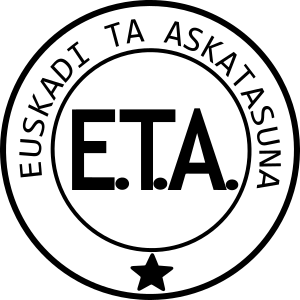ETA (separatist group) facts for kids
Quick facts for kids Euskadi Ta Askatasuna |
|
|---|---|
| Participant in Basque conflict | |

Euskadi Ta Askatasuna's symbol
|
|
| Active | 31 July 1959 – 16 April 2018
|
| Ideology |
|
| Leaders |
|
| Headquarters | Greater Basque Country |
| Area of operations |
|
| Allies |
|
| Opponents |
|
ETA (which stands for "Basque Homeland and Liberty" or "Basque Country and Freedom") was a group that wanted to create a separate country for the Basque people. The Basque people are a unique group living in parts of northern Spain and southwestern France. Many of them speak a special language called Euskara. ETA was a militant group, meaning they used violence to try and achieve their goals.
Contents
What Was ETA?
ETA was one of Europe's most well-known and long-lasting militant groups. It was started in 1959. The group formed because some people were unhappy with the main Basque political party. They felt it was not doing enough to achieve an independent Basque country.
Why Was ETA Formed?
ETA was created from an earlier group called EKIN. Both groups were formed because people wanted a stronger push for Basque independence. They felt the main Basque party was too moderate. ETA believed that using force was the only way to get their own nation.
How Did ETA Operate?
ETA carried out many attacks in Spain. They also had connections with other similar groups, like the Provisional Irish Republican Army (IRA) and Colombia's FARC. Most of ETA's attacks targeted businesses and Spanish government officials. This included members of the police and judges. However, they also attacked regular people. Their main methods were bombings and assassinations. These attacks happened mostly in the Basque Country, Madrid, and Catalonia. Sometimes, like the IRA, ETA would give warnings before an attack.
Key Events and Attacks
In December 1973, ETA assassinated Admiral Luis Carrero Blanco. He was seen as a possible future leader of Spain after the dictator, Francisco Franco. Blanco was killed when a bomb exploded under his car. Many years later, ETA almost assassinated Jose Maria Aznar, who later became prime minister of Spain. In 1987, ETA killed 21 people in Barcelona with a car bomb.
Changes in ETA's Status
After Francisco Franco's rule ended and Spain became a democracy in 1979, the situation for the Basque region changed a lot. Franco had tried to stop Basque nationalism. But the new democratic government gave the Basque provinces a lot of autonomy, meaning they could govern themselves more. In 1980, the Basque region got its own parliament. It also gained the right to make its own tax laws. The Basque language, Euskara, also became more important in public life and schools.
However, these changes did not stop ETA. The group continued its violent actions. Over the years, ETA was responsible for about 900 murders and many kidnappings.
The End of ETA's Violence
ETA's activity changed over time. They tried to have several ceasefires, which are agreements to stop fighting. One ceasefire lasted 14 months until December 1999. Although there were still some attacks after 2000, ETA caused fewer deaths. The group was believed to be getting smaller. Spanish officials thought that police actions had weakened ETA.
In March 2006, ETA announced a permanent ceasefire. They said they wanted to join the political process. This decision might have been influenced by the 2004 Madrid train bombings. Those attacks killed nearly 200 people. They were first blamed on ETA but were later found to be the work of other militant groups. Some believe ETA leaders felt that such large-scale attacks made their own violent methods look bad.
However, in June 2007, ETA ended its 2006 ceasefire. They accused the Spanish government of interfering in Basque elections and continuing to arrest ETA members. It's important to know that ETA never officially gave up violence or started getting rid of its weapons during these ceasefires.
ETA's Final Steps
On October 20, 2011, ETA publicly announced that it was definitely stopping its armed activities. They still said they wanted an independent Basque state. This announcement was made in two well-known Basque newspapers.
Finally, in May 2018, ETA announced that it was formally disbanding. This decision marked the end of more than 50 years of violence. This long period of conflict had resulted in the deaths of over 800 people.
ETA in Pop Culture
- In the video game Counter-Strike: Global Offensive, a group called The Separatists represents ETA. They appear as playable characters on certain maps in the game.
Images for kids
-
A pro-ETA mural in Durango, Biscay.
-
Graffiti in Pasaia (2003). It says "ETA, the people with you" and asks for "Independence!".
-
A memorial plate at the site where Admiral Luis Carrero Blanco was assassinated.
-
A mural in Belfast showing support for Basque nationalism.
See also
 In Spanish: Euskadi Ta Askatasuna para niños
In Spanish: Euskadi Ta Askatasuna para niños
- Etxerat
- José Larrañaga Arenas
- Felix Likiniano
- Julen Madariaga
- Kasilda Hernáez









